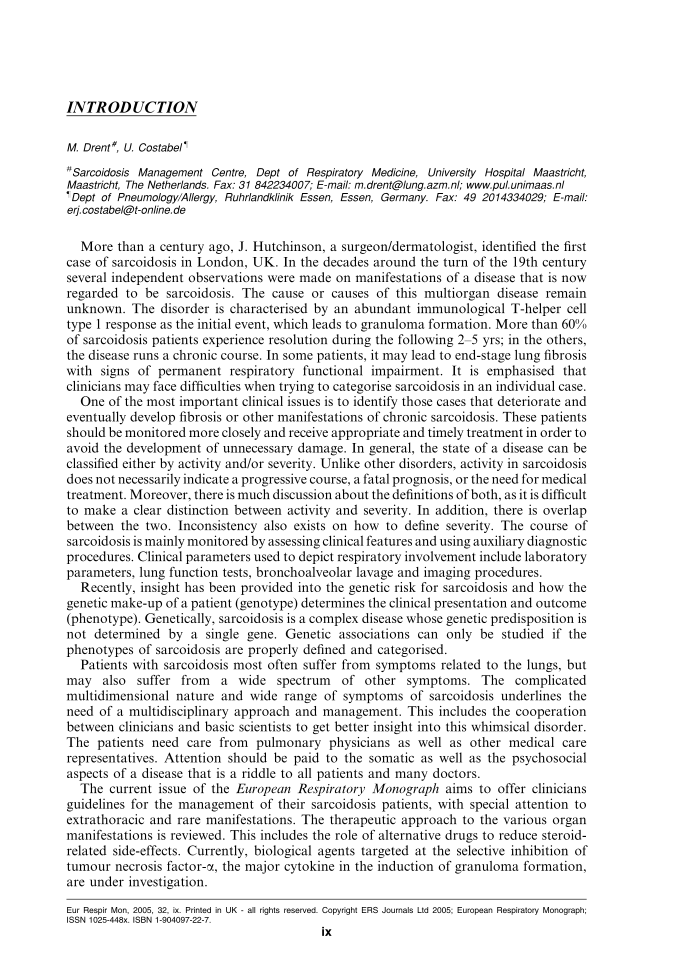INTRODUCTION M. Drent # , U. Costabel } # Sarcoidosis Management Centre, Dept of Respiratory Medicine, University Hospital Maastricht, Maastricht, The Netherlands. Fax: 31 842234007 E-mail: m.drent@lung.azm.nl www.pul.unimaas.nl } Dept of Pneumology/Allergy, Ruhrlandklinik Essen, Essen, Germany. Fax: 49 2014334029 E-mail: erj.costabel@t-online.de More than a century ago, J. Hutchinson, a surgeon/dermatologist, identified the first case of sarcoidosis in London, UK. In the decades around the turn of the 19th century several independent observations were made on manifestations of a disease that is now regarded to be sarcoidosis. The cause or causes of this multiorgan disease remain unknown. The disorder is characterised by an abundant immunological T-helper cell type 1 response as the initial event, which leads to granuloma formation. More than 60% of sarcoidosis patients experience resolution during the following 2–5 yrs in the others, the disease runs a chronic course. In some patients, it may lead to end-stage lung fibrosis with signs of permanent respiratory functional impairment. It is emphasised that clinicians may face difficulties when trying to categorise sarcoidosis in an individual case. One of the most important clinical issues is to identify those cases that deteriorate and eventually develop fibrosis or other manifestations of chronic sarcoidosis. These patients should be monitored more closely and receive appropriate and timely treatment in order to avoid the development of unnecessary damage. In general, the state of a disease can be classified either by activity and/or severity. Unlike other disorders, activity in sarcoidosis does not necessarily indicate a progressive course, a fatal prognosis, or the need for medical treatment. Moreover, there is much discussion about the definitions of both, as it is difficult to make a clear distinction between activity and severity. In addition, there is overlap between the two. Inconsistency also exists on how to define severity. The course of sarcoidosis is mainly monitored by assessing clinical features and using auxiliary diagnostic procedures. Clinical parameters used to depict respiratory involvement include laboratory parameters, lung function tests, bronchoalveolar lavage and imaging procedures. Recently, insight has been provided into the genetic risk for sarcoidosis and how the genetic make-up of a patient (genotype) determines the clinical presentation and outcome (phenotype). Genetically, sarcoidosis is a complex disease whose genetic predisposition is not determined by a single gene. Genetic associations can only be studied if the phenotypes of sarcoidosis are properly defined and categorised. Patients with sarcoidosis most often suffer from symptoms related to the lungs, but may also suffer from a wide spectrum of other symptoms. The complicated multidimensional nature and wide range of symptoms of sarcoidosis underlines the need of a multidisciplinary approach and management. This includes the cooperation between clinicians and basic scientists to get better insight into this whimsical disorder. The patients need care from pulmonary physicians as well as other medical care representatives. Attention should be paid to the somatic as well as the psychosocial aspects of a disease that is a riddle to all patients and many doctors. The current issue of the European Respiratory Monograph aims to offer clinicians guidelines for the management of their sarcoidosis patients, with special attention to extrathoracic and rare manifestations. The therapeutic approach to the various organ manifestations is reviewed. This includes the role of alternative drugs to reduce steroid- related side-effects. Currently, biological agents targeted at the selective inhibition of tumour necrosis factor-a, the major cytokine in the induction of granuloma formation, are under investigation. Eur Respir Mon, 2005, 32, ix. Printed in UK - all rights reserved. Copyright ERS Journals Ltd 2005 European Respiratory Monograph ISSN 1025-448x. ISBN 1-904097-22-7. ix
